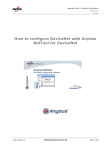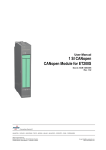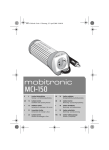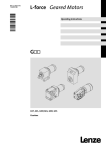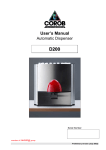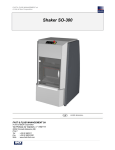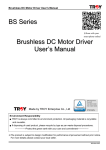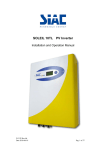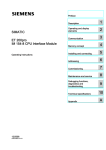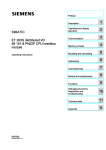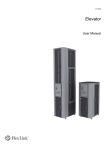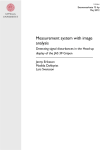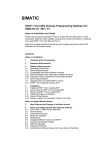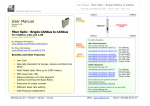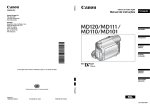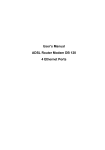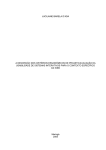Download Application Note 1 SI Transparent CAN Function Blocks
Transcript
Application Note 1 SI Transparent CAN Function Blocks SCM-1300-005 Rev 1.00 Application Note 1 SI Transparent CAN Function Blocks HMS Industrial Networks AB Page 1 (30) Application Note 1 SI Transparent CAN Function Blocks SCM-1300-005 Rev 1.00 Important User Information This document is intended to provide a good understanding of the function block functionality offered with the 1 SI CANopen module for ET200S when using the Transparent CAN functionality. The reader of this document is expected to be familiar with high level software design and communication systems in general. Liability Every care has been taken in the preparation of this application note. Please inform HMS Industrial Networks AB of any inaccuracies or omissions. The data and illustrations found in this document are not binding. We, HMS Industrial Networks AB, reserve the right to modify our products in line with our policy of continuous product development. The information in this document is subject to change without notice and should not be considered as a commitment by HMS Industrial Networks AB. HMS Industrial Networks AB assumes no responsibility for any errors that may appear in this document. There are many applications of this product. Those responsible for the use of this device must ensure that all the necessary steps have been taken to verify that the applications meets all performance and safety requirements including any applicable laws, regulations, codes, and standards HMS Industrial Networks AB will under no circumstances assume liability or responsibility for any problems that may arise as a result from the use of undocumented features, timing, or functional side effects found outside the documented scope of this product. The effects caused by any direct or indirect use of such aspects of the product are undefined, and may include e.g. compatibility issues and stability issues. The examples and illustrations in this document are included solely for illustrative purposes. Because of the many variables and requirements associated with any particular implementation, HMS Industrial Networks AB cannot assume responsibility for actual use based on these examples and illustrations. Intellectual Property Rights HMS Industrial Networks AB has intellectual property rights relating to technology embodied in the product described in this document. These intellectual property rights may include patents and pending patent applications in the US and other countries. Trademark Acknowledgements All trademarks are the property of their respective holders. HMS Industrial Networks AB Page 2 (30) Application Note 1 SI Transparent CAN Function Blocks SCM-1300-005 Rev 1.00 Document History Revision 0.90 Date 2011-01-24 Description Created Author Lars-Åke Väldesjö 0.91 2011-02-11 Internal update Lars-Åke Väldesjö 0.92 2011-08-18 Updated with more details Mikael Mårtensson 0.93 2011-08-26 Updated after review Mikael Mårtensson 1.00 2011-09-29 First Release Kaspar Dahlqvist Referenced Documents Document name Author Document id. Revision 1 SI CANopen User Manual HMS SCM-1200-005 1.30 More Information About the Product The latest information can be downloaded from www.et200can.com. HMS Industrial Networks AB Page 3 (30) Application Note 1 SI Transparent CAN Function Blocks SCM-1300-005 Rev 1.00 Contents 1. Required Equipment and Software ........................................................................................................ 5 2. Application Note Overview...................................................................................................................... 6 2.1. Purpose ............................................................................................................................................... 6 2.2. Prerequirements .................................................................................................................................. 6 2.3. Detailed Description ........................................................................................................................... 6 3. The CAN-frame (2.0A)............................................................................................................................. 8 4. How to Import Blocks into the STEP7 Project .................................................................................... 10 5. Hardware Configuration in STEP 7 ..................................................................................................... 12 6. Initialization of Transparent CAN Example ....................................................................................... 14 6.1. Important Comments about the Code ............................................................................................... 14 7. CAN Control Function Block ................................................................................................................ 18 7.1. How to Configure the CAN Control Function Block ....................................................................... 18 8. CAN Status Function Block................................................................................................................... 20 8.1. How to Configure the CAN Status block ......................................................................................... 20 9. CAN Send Function Block ..................................................................................................................... 22 9.1. How to Configure the CAN Send block ........................................................................................... 22 10. CAN Receive Function Block ............................................................................................................ 24 10.1. How to Configure the CAN Receive block .................................................................................. 24 11. The Use of OB82 to get Group Diagnostics Interrupt..................................................................... 26 11.1. Diagnostic Interrupt (OB82)......................................................................................................... 26 11.2. Programming OB82 ..................................................................................................................... 26 11.3. OB82 Sample Code ...................................................................................................................... 27 12. Use of Variables in “Transparent CAN” Example.......................................................................... 28 12.1. Explanation of Variables in VAR Table ...................................................................................... 28 12.2. CAN-log ....................................................................................................................................... 29 12.3. Data in Digital Input/Output Blocks............................................................................................. 30 HMS Industrial Networks AB Page 4 (30) Application Note 1 SI Transparent CAN Function Blocks SCM-1300-005 Rev 1.00 1. Required Equipment and Software The following items are needed to perform the installation according to the example file: Description Name / Type Version Hardware ET200S system Either IM-type connected to PLC or CPU-type as standalone. See further information in User Manual in appendix “Siemens Interface Modules Compatibility” An IM151-8 PN/DP CPU rack is used standalone in the example. (6ES7 151-8AB00-0AB0) Power module (6ES7 138-4CA50-0AB0) Input module (6ES7 131-4BF00-0AA0) Output module (6ES7 132-4BF00-0AA0) Two 1 SI CANopen Modules configured as slaves 020570-B 2.11 or later SIMATIC STEP7 tool N/A V5.4 SP 5 or later USB to CAN adapter 020810-B Software ( Only to monitor CAN-traffic, not required) PLC Function blocks for Transparent CAN (2.0A) From www.et200can.com 1.01 or later HSP 2066 (STEP7 configuration file) or GSD files for the 1 SI CANopen Module From www.et200can.com 1.00 or later CANopen cables N/A N/A PLC configuration cable N/A N/A Other HMS Industrial Networks AB Page 5 (30) Application Note 1 SI Transparent CAN Function Blocks SCM-1300-005 Rev 1.00 2. Application Note Overview 2.1. Purpose The purpose of this application note is to describe the use of function blocks available for the Transparent CAN functionality of the 1 SI CANopen module. This application note describes how to import, compile and use the Transparent CAN Function Blocks available for download from www.et200can.com. It also refers to an example consisting of a STEP7 project. In the STEP7 example an IM151-8 PN/DP CPU (6ES7 1518AB00-0AB0) is used with the program running in the internal CPU. The example program will use 2 1 SI CANopen modules. Initialize one (Node 2) to operate in Transparent CAN mode (see “6 Initialization of Transparent CAN Example” for details), and the second to operate in CANopen mode (Node 1). Set the network to OPERATIONAL by sending the CANopen command “Go to Operational”. The program will then transfer 4 bytes from Node 1 to Node 2 with the value 01020304h, and 4 bytes from Node 2 to Node 1 with the value AABBCCDDh. It will also allow the user to monitor the status of the Transparent CAN module by using the CAN Status function block. 2.2. Prerequirements Two 1 SI CANopen modules should be mounted in an IM151-8 PN/DP CPU with reference 6ES7 1518AB00-0AB0 (other ET200 systems can be used, but in that case the ET200S system has to be changed in the example project before download) and a CANopen cable should be connected between the two modules with correct termination (see section “Installation” in the user manual for details on how to connect the two modules). The program downloaded with this application note should be downloaded into the ET200S system. If the CAN network should be monitored, the CAN analyzer must also be connected to the CAN network. 2.3. Detailed Description The example program will transfer a CANopen PDO message (CAN frame) from the CANopen module (Node 1), with the contents 01020304h, to the Transparent CAN node (Node 2). This CAN frame will be received in the module (Node 2), setup to operate in Transparent CAN mode, by the CAN Receive function block (see “10 CAN Receive Function Block” for details). The example program will also send one CAN frame (with the contents of a CANopen SDO Write command) from the Transparent CAN node (Node 2) CAN Send function block (see “9 CAN Send Function Block” for details). This frame will be received as an SDO command in the CANopen module (Node 1), writing data AABBCCDDh to the first 4 bytes of the memory area (the response to the SDO request will also be received by the Transparent CAN receive block). The example program will also show how to use the CAN Status function block (see “8 CAN Status Function Block” for details) to see the amount of frames that has been received in the Transparent CAN node (Node 2). The section below describes the example step by step. The document assumes that the reader is familiar with industrial communication as well as CAN and Siemens STEP7. HMS Industrial Networks AB Page 6 (30) Application Note 1 SI Transparent CAN Function Blocks SCM-1300-005 Rev 1.00 1. The two modules will start up and send out BOOTUP messages on CAN (See section “12.2 CANlog” row 1 and 2). 2. The 1 SI CANopen Module (Node 2) will be set in Transparent CAN mode and configured by Network 10 (see “6 Initialization of Transparent CAN Example” for details) and a NMT command “Go to Operational” will be sent (RUN-LED on CANopen slave module (Node 1) will go to stable green (Operational)). See section “12.2 CAN-log” row 3. 3. The slave node will send out its four default PDOs (they will be received by the Transparent CAN node via function block CAN Receive). See section “12.2 CAN-log” row 4 to 7. 4. Start to monitor variables in STEP7 VAR table “Transparent CAN”. 5. Enter the value 01020304h for QD32 (row 25) in the VAR-table and press F9 to transfer the new value to the module. This makes the slave send out its updated PDO (COBID 181h). See section “12.2 CAN-log” row 8. (Change the data in row 25 to make a new transmission of the PDO (COBID 181h) or change IO in the digital input module). The PDO (COBID 181h) is received by the Transparent CAN node (Node 2) via function block CAN Receive. 6. F9 will also set appropriate data to be sent out via a SDO Write command by setting “CAN Send REQ” to TRUE on row 15. Data AABBCCDDh will be set in the first 4 bytes of the slave. The SDO-response from the slave is received by the Transparent node, function block CAN_RCV. (“CAN Send REQ” is cleared after every transmission). See section “12.2 CAN-log” row 9 for SDOcommand and row 10 for response. 7. Continue to set “CAN Send REQ” four more times so that “CANSTAT STAT” on row 5 changes to 10hex, indicating that the Buffer Limit in the Receiver is reached. 10 or more messages are received without being read out from the 1 SI CANopen Module: (When more than 127 messages are in the buffer, “CANSTAT STAT” is changed to 18h, indicating that the buffer is half full. When the buffer is full and the first message is lost, “CANSTAT STAT” is changed to 1Ch, indicating that the buffer is full). 8. Every time “CAN Reci ACK p out” is set, the next received CAN-frame will be shown in VAT lines 9-13 (CAN-frame data). (The data in CANSTAT STAT will change if buffer goes under actuating levels.) HMS Industrial Networks AB Page 7 (30) Application Note 1 SI Transparent CAN Function Blocks SCM-1300-005 Rev 1.00 3. The CAN-frame (2.0A) The standard CAN frame consists of the following bits: Figure 1 • • • • • Standard CAN frame SOF, IDE, r0, CRC, ACK, EOF, IFS - Control bits and CRC used for CAN communication. No change needed. This will be handled automatically by the software. Identifier - The Standard CAN 11-bit identifier establishes the priority of the message. The lower the binary value, the higher its priority. Also referred to as COBID. RTR - The single Remote Transmission Request bit is set high when information is required from another node. All nodes receive the request, but the identifier determines the specified node. The responding data is also received by all nodes and used by any node interested. In this way all data being used in a system is uniform. DLC - The 4-bit data length code (DLC) contains the number of bytes of data being transmitted. Data - Up to 8 bytes of application data may be transmitted in one CAN frame. NOTE: Extended (29-bit) identifiers (2.0B) are not supported by the 1 SI CANopen module in Transparent CAN mode. HMS Industrial Networks AB Page 8 (30) Application Note 1 SI Transparent CAN Function Blocks SCM-1300-005 Rev 1.00 HMS Industrial Networks AB Page 9 (30) Application Note 1 SI Transparent CAN Function Blocks SCM-1300-005 Rev 1.00 4. How to Import Blocks into the STEP7 Project The four function blocks handling the Transparent CAN functionality have to be imported and compiled into your STEP7 project. The available function blocks for Transparent CAN are “CAN Receive”, “CAN Send”, “CAN Control” and “CAN Status”. This is done by following the steps below. Figure 2 Select external source for blocks. 1. Select “Sources” 2. Right click in white area and select “Insert New Object” from “External Source” Figure 3 Select files. 3. Select the files needed and press “OPEN” Figure 4 Compile Blocks. HMS Industrial Networks AB Page 10 (30) Application Note 1 SI Transparent CAN Function Blocks SCM-1300-005 Rev 1.00 4. To compile the blocks: select the files, right click and choose compile Note: English language is required in STEP7 for the compilation to succeed. Figure 5 Insert Block from “FB blocks”. 5. Close "compile windows". The blocks can now be selected from FB blocks. They have now been given numbers as below: FB106: Named “CAN Send” in symbol table in example code. FB107: Named “CAN Receive” in symbol table in example code. FB108: Named “CAN Control” in symbol table in example code. FB109: Named “CAN Status” in symbol table in example code. HMS Industrial Networks AB Page 11 (30) Application Note 1 SI Transparent CAN Function Blocks SCM-1300-005 Rev 1.00 5. Hardware Configuration in STEP 7 When the hardware has been setup the STEP7 project has to be configured accordingly. This is done by the following steps. First set up the backplane size of the module. This is done by selecting the appropriate module from the “hardware list” under “Special modules”. In the example two 16 byte 1 SI CANopen modules are used. Figure 6 Hardware configuration, hardware list. NOTE: A 16 or 32 byte module is necessary for Transparent CAN to work HMS Industrial Networks AB Page 12 (30) Application Note 1 SI Transparent CAN Function Blocks SCM-1300-005 Rev 1.00 When the two modules have been selected the appropriate offset has to be configured. Double click the appropriate module and select the “Addresses” tab. In this example we use offset 32 for the CANopen node and offset 64 for the Transparent CAN node. Figure 7 Hardware configuration, hardware list. When the two offsets have been configured, the settings for each node have to be changed. This is done by selecting the “Parameters” tab in the same window. The same setting can be used for all parameters except “Node number” that have to be set to 1 for the CANopen node and 2 for the Transparent CAN node. See settings below. Figure 8 Setting properties for the first 1 SI CANopen Module (Node 1). Download the hardware configuration to the ET200S system. NOTE: The example code requires that the I/O of the 1 SI CANopen module is in the process image. HMS Industrial Networks AB Page 13 (30) Application Note 1 SI Transparent CAN Function Blocks SCM-1300-005 Rev 1.00 6. Initialization of Transparent CAN Example The initialization of Transparent CAN in the 1 SI CANopen module is made, in this example, by using Network 10 in section OB1 of the STEP7 example project. The functionality of the state machine in Network 10 is described in the network as comments, and a short functional description is also made in the “header” of the network as well as in the text below. The PLC-program makes the module with node ID 2 switch from CANopen mode to Transparent CAN mode by sending a CAN Control message with FCN= 0 (RUN-LED will flash three times to indicate the correct mode). The PLC-program sets the Transparent CAN node to receive all messages by sending a CAN Control message with FCN= 1, LEN=1 and PARAM=FFFFh (receive all COBIDs). The next step for the PLC-program is to set Buffer Limit Reached in Transparent node to 0Ah (10 Decimal), by sending a CAN Control message with FCN= 2, LEN=1 and PARAM=000Ah. The PLC-program makes the Transparent node send the “Go to Operational” command to the other node by sending a CAN Send message with RTR=0, COBID= 0, DATA=01 00 and CANSIZE=02h. This is done to make the CANopen slave node send out its PDOs. 6.1. Important Comments about the Code - If the CAN Receive Block is not set to the “repower” state when the 1 SI CANopen module is restarted, the Block and the module can become unsynchronized. This is done by resetting bits “fActive”, “BUSY” and “NEW” in the Data Base for the Block. - In state 1 below RET1: The filter setting for the CAN Receive block can be setup to receive only the COBIDs required. In the example all COBIDs are received. It is however recommended to setup the COBIDs actually used, to decrease the load of the PLC and let the module transfer only the required messages to the PLC. (An example on how to enable COBIDs 602 and 181 is entered into the project as a comment, and also change LEN to the number of parameters given). - In state 2 below RET2: The limit for BUFFER LIMIT REACHED can be changed by modifying the value A0000 (10 messages) to the appropriate value. The first word of the double-word is used as only one parameter is given. - When the initialization is done the state machine stays in state 4. o By setting bit 0 to TRUE in "1_INITS_TRANS", MB117, the state-machine clears the Rxbuffer in CAN Receive. o By setting bit 1 to TRUE in "1_INITS_TRANS", MB117, the state-machine clears the BUS OFF-condition. HMS Industrial Networks AB Page 14 (30) Application Note 1 SI Transparent CAN Function Blocks SCM-1300-005 Rev 1.00 Below is a screen dump of Network 10: //If 1_INITS_TRANS is = 0 (Power up) Enable transparent CAN. L L <>I JCB 0 "1_INITS_TRANS" ST01 // If 0 continue below else test next state. A JCB "CANCTRL BUSY" ST00 // Jump out if still BUSY A JNB "Delaytimer Out" ST00 // Jump out if start delay timer is running // Set CAN Receive to repower state by clearing fActive-bit, BUSY-bit and NEW-bit // In CAN Receive DB (OBS! Correct DB for CAN Receive has to be called). R "CAN Receive DB135".fActive R "CAN Receive DB135".BUSY R "CAN Receive DB135".NEW RET0: NOP 0 L T L T L T S 0 "CANCTRL 0 "CANCTRL 0 "CANCTRL "CANCTRL L T 1 "1_INITS_TRANS" // 1 Count up state machine. JU ST00 // Jump to THE END 0 // State 1 Enable Receiver ST01: NOP // Enable transparent CAN FCN" LEN" PARAM" REQ" L L <>I JCB 1 "1_INITS_TRANS" ST02 // If 1 continue below else test next state. A JCB "CANCTRL BUSY" ST00 // Jump out if still BUSY L L <>I JCB 0 "CANCTRL RET" RET1: NOP L T L RET0 0 T S 1 "CANCTRL FCN" 1 2 "CANCTRL LEN" DW#16#FFFF0000 DW#16#86028181 "CANCTRL PARAM" "CANCTRL REQ" L 2 // L T L // L // If CANCTRL RET says Error try "Enable transparent CAN" again. // Enable receiver for all incomming CAN-frames // (1) Works with RECEIVE all COB-id:s, data FFFF0000 // (2) Works with RECEIVE COB-id 602 and 181 below // (1) Works with 1 as LEN // (2) Works with 2 as LEN above (RECEIVE COB-id 602 and 181) // Enable CAN CTRL REQ // 2 Count up state machine. HMS Industrial Networks AB Page 15 (30) Application Note 1 SI Transparent CAN Function Blocks SCM-1300-005 Rev 1.00 T "1_INITS_TRANS" JU ST00 // Jump to THE END 0 // State 2 set buffer limit to 10 ST02: NOP L L <>I JCB 2 "1_INITS_TRANS" ST03 // If 2 continue below else test next state. A JCB "CANCTRL BUSY" ST00 // Jump out if still BUSY L L <>I JCB 0 "CANCTRL RET" RET2: NOP L T L T L T S L T JU ST03: NOP RET1 // If CANCTRL RET says Error try "Enable Receiver" again. 0 2 "CANCTRL FCN" 0 "CANCTRL LEN" DW#16#A0000 "CANCTRL PARAM" "CANCTRL REQ" 3 "1_INITS_TRANS" ST00 // Set BUFFER LIMIT REACHED 0 // L L <>I JCB A JCB L L <>I JCB 3 "1_INITS_TRANS" // Set limit to 10 (0x000A 0000) // Enable CAN CTRL REQ // 3 Count up state machine. // Jump to THE END Send "Goto Operational" with CAN SEND command. ST04 "CANCTRL BUSY" ST00 0 "CANCTRL RET" // If 3 continue below else test next state. // Jump out if still BUSY RET2 // If CANCTRL RET says Error try "set buffer limit to 10" again. A JCB "CAN Send BUSY" ST00 // Jump out if still BUSY L T L T L T L T S 0 "CAN Send COBID" DW#16#1000000 "CAN Send DATA1" DW#16#0 "CAN Send DATA2" 2 "CAN Send SIZE" "CAN Send REQ" // Set COB-ID to 0 L T 4 "1_INITS_TRANS" // 4 Count up state machine. JU ST00 // Jump to THE END 0 // 4 Rest state ST04: NOP L L <>I JCB S S ST05: NOP // Set data to 0100 (0x0100 0000) // Clear rest of data to 0000 (0x0000 0000) // Send first two bytes of data // Enable CAN Send REQ 4 "1_INITS_TRANS" ST05 "CAN Reci REQ" "CANSTAT REQ" // If 4 continue below else test next state. // Enable Receiver block // Enable Status block 0 // Reset Rx buffer state L L <>I JCB A JCB 5 "1_INITS_TRANS" ST06 "CANCTRL BUSY" ST00 // If 5 continue below else test next state. // Jump out if still BUSY L 3 // Set Reset Rx buffer HMS Industrial Networks AB Page 16 (30) Application Note 1 SI Transparent CAN Function Blocks SCM-1300-005 Rev 1.00 T L T S L T JU ST06: NOP L L <>I JCB A JCB L T L T S L T JU ST00: NOP "CANCTRL FCN" 0 "CANCTRL LEN" "CANCTRL REQ" 4 "1_INITS_TRANS" ST00 0 // Enable CAN CTRL REQ // 4 Go to rest state. // Jump to THE END // Reset BUS OFF state 6 "1_INITS_TRANS" ST00 "CANCTRL BUSY" ST00 5 "CANCTRL FCN" 0 "CANCTRL LEN" "CANCTRL REQ" 4 "1_INITS_TRANS" ST00 // If 6 continue below else jump to THE END. // Jump out if still BUSY 0 // Here is THE END // Reset BUS OFF // Enable CAN CTRL REQ // 4 Go back to rest state. // Jump to THE END HMS Industrial Networks AB Page 17 (30) Application Note 1 SI Transparent CAN Function Blocks SCM-1300-005 Rev 1.00 7. CAN Control Function Block This block is used to control the state of the transparent CAN layer and to set its parameters. It consists of 5 different function calls. Function (FCN) Description 0 Enables Transparent CAN mode. All ordinary CANopen functionality is disabled, and the module has to be restarted to re-enable CANopen functionality. The rest of the function codes in CAN Control can only be used if the Transparent CAN mode is enabled. 1 Configures the CAN Receive acceptance filter in the module, i.e. what COBIDs will be accepted when receiving data frames. The module will not listen to the CAN bus, if no COBID in the filter is enabled. The acceptance filter can be changed at any time. 2 Configures the warning limit for the CAN Receive buffer. It gives the opportunity to define the amount of frames that will be stored in the receive buffer, before the BUFFER LIMIT REACHED in the status code is set. 3 Empties the receive buffer. CAN Receive still holds the latest frame that has not been acknowledged (NEW is cleared by holding ACK high for on scan cycle). 5 Clears BUS OFF condition. If a BUS OFF condition is generated, the CAN controller has to be reset, before communication can be resumed. 7.1. How to Configure the CAN Control Function Block Load the function block “CAN Control” into a network and set input and output data. Figure 9 CAN Control block HMS Industrial Networks AB Page 18 (30) Application Note 1 SI Transparent CAN Function Blocks SCM-1300-005 Rev 1.00 Inputs: Name Explanation Example info DBx Enter a data block id DBx where x is unique. (Used by the function block for internal data variables and calculations) DB100 REQ If TRUE for one scan cycle of the PLCprogram, a CAN Control request is started (see RET below for handling instructions for REQ) “CANCTRL REQ”: M100.1 ID Logic address for the position where the INPUT data starts for the 1 SI CANopen module in the rack. • DW#16#: Data is entered as doubleword in hex • 40: The actual first address in hex, I64 (decimal) set in Hardware Configuration of the module FCN Select the function that will be sent to the module. • “CANCTRL FCN”: MB101 LEN Only valid when FCN = 1, otherwise ignored. Defines the size of the acceptance filter array that is sent in PARAM. • “CANCTRL LEN”: MW102 PARAM • P#M: Pointer to M-area Place and maximum size of the location that holds the Parameters to be sent along • 104.0: Start address in M-area with the function. Only valid when FCN = • WORD 2: Maximum size to use in M-area (up to two Parameters of word size in this example) 1 or 2: FCN Contents EN 1 Acceptance filter array 2 Buffer limit value TRUE runs the CAN Control block. Always run in example. Outputs: Name Explanation Example info ENO Not used in this example. - BUSY If the request is not finished within one scan cycle, BUSY turns TRUE and stays TRUE until the request is finished, when it returns to FALSE. “CANCTRL BUSY”: M100.0 RET Holds result from execution of block. Available when “CANCTRL RET”: MW108 BUSY turns FALSE, until REQ is set to TRUE again. For Error codes, see appendix “Error Codes (RET)” in User manual. HMS Industrial Networks AB Page 19 (30) Application Note 1 SI Transparent CAN Function Blocks SCM-1300-005 Rev 1.00 8. CAN Status Function Block This block is used to request the status of the module. The status value is found in the parameter STAT. The status code is represented by 32 bits, where each bit represents a status code. NOTE: If Group Diagnosis is enabled in the module via HW configuration in STEP7, the channel diagnostics interrupt will report “External error” as long as any bit in the Status Code is set. Status code Name Description 0x00000000 NO ERRORS - 0x00000001 BUS OFF The CAN error counter have passed BUS OFF level. 0x00000002 ERROR PASSIVE The CAN error counter has passed the warning level. 0x00000004 BUFFER FULL 255 messages are stored, and the receive buffer is full. Reset by reading out one message from the buffer. 0x00000008 BUFFER HALF FULL Set when 128 messages are stored in the receive buffer, i.e. the buffer is half full. 0x00000010 BUFFER LIMIT REACHED Set at 255 initially, can be changed by FCN 2, see “CAN Control” 8.1. How to Configure the CAN Status block Load the function block “CAN Status” into a network and set input and output data. Figure 10 CAN Status block HMS Industrial Networks AB Page 20 (30) Application Note 1 SI Transparent CAN Function Blocks SCM-1300-005 Rev 1.00 Inputs: Name Explanation Example info DBx Enter a data block id DBx where x is unique. (Used by the function block for internal data variables and calculations) DB110 REQ TRUE for one scan cycle of the PLCprogram starts the CAN Status (see RET below for handling instructions for REQ) “CANSTAT REQ”: M110.1 ID Logic address for the position where the INPUT data starts for the 1 SI CANopen module in the rack. • DW#16#: Data is entered as doubleword in hex • 40: The actual first address in hex, I64 (decimal) set in Hardware Configuration of the module EN TRUE runs the CAN Status block Always run Outputs: Name Explanation Example info ENO Not used in this example. - STAT The returned status of the module “CANSTAT STAT”: MD111 BUSY If the request is not finished within one scan cycle, BUSY turns TRUE and stays TRUE until the request is finished, when it returns to FALSE. “CANSTAT BUSY”: M110.0 RET Holds result from execution of block. Available when “CANSTAT RET”: MW115 BUSY turns FALSE, until REQ is set to TRUE. For Error codes, see appendix “Error Codes (RET)” in User manual. HMS Industrial Networks AB Page 21 (30) Application Note 1 SI Transparent CAN Function Blocks SCM-1300-005 Rev 1.00 9. CAN Send Function Block The CAN Send function block handles the frames that are sent from the 1 SI CANopen Module in Transparent CAN mode (Node 2) to the CAN bus. When REQ turns TRUE, a CAN frame is sent according to the parameters defined by the user. When the frame has been acknowledged by the module, BUSY will go FALSE, and a new frame can be sent. This will continue as long as REQ is set to TRUE. 9.1. How to Configure the CAN Send block Load the function block “CAN Send” into a network and set input and output data. CAN Send block HMS Industrial Networks AB Page 22 (30) Application Note 1 SI Transparent CAN Function Blocks SCM-1300-005 Rev 1.00 Inputs: Name Explanation Example info DBx Enter a data block id DBx where x is unique. (Used by the function block for internal data variables and calculations) DB120 REQ TRUE for one scan cycle of the PLCprogram starts the CAN Send request (see RET below for handling instructions for REQ) “CAN Send REQ”: M120.1 LADDR_ IN Set logic address for the position where the INPUT data starts for the 1 SI CANopen module in the rack. • W#16#: Data put in as word in hex • 40: The actual first address in hex, I64 (decimal) set in Hardware Configuration of the module LADDR_ OUT Set logic address for the position where the OUTPUT data starts for the 1 SI CANopen module in the rack. • W#16#: Data put in as word in hex • 40: The actual first address in hex, Q64 (decimal) set in Hardware Configuration of module BPSIZE Set 1SI CANopen module backplane size. The size of selected module from Hardware Configuration • B#16#: Data put in as bytes in hex • 10: The actual size in hex. Put in 10h for a 16 byte module. RTR Remote Transmission Request bit on the CAN net “CAN Send RTR”: M120.2 COBID The standard CAN 11-bit identifier (COBID) is placed in a Word “CAN Send COBID”: MW121 DATA Place and maximum size of the location to read the data to send (up to eight bytes of data can be sent via CAN) • P#M: Pointer to M-area • 123.0: Start address in M-area • BYTE 8: Data size of the M-area CANSIZE Number of bytes to send “CAN Send SIZE”: MB131 ABORT Aborts the current transmission when set to TRUE (if BUS OFF is reached, ABORT transmission and clear BUS OFF condition, CAN Control function 5.) “CAN Send ABORT”: M120.3 EN TRUE runs the CAN Send block Always run Outputs: Name Explanation Example info ENO Not used in this example. - BUSY If the request is not finished within one scan cycle, BUSY turns TRUE and stays TRUE until the request is finished, when it returns to FALSE. “CAN Send BUSY”: M120.0 RET Holds result from execution of block. Available when BUSY turns FALSE, until REQ is set to TRUE again. For Error codes, see appendix “Error Codes (RET)” in User manual. “CAN Send RET”: MW132 HMS Industrial Networks AB Page 23 (30) Application Note 1 SI Transparent CAN Function Blocks SCM-1300-005 Rev 1.00 10. CAN Receive Function Block CAN Receive handles the frames that have been received from the 1 SI CANopen Module in Transparent CAN mode. When REQ is TRUE, the block looks for new frames waiting in the CAN buffer of the module. If there are any, the module will read the oldest frame, set NEW to TRUE, and wait for an ACK. This will be repeated until all frames have been read. When all frames have been read BUSY will go FALSE. The received frames will be buffered until they are read by the PLC. The buffer can hold up to 255 frames. For polling operation, set REQ to TRUE permanently. NOTE: ACK must be reset to FALSE after one scan cycle. Otherwise incoming frames will automatically be acknowledged as read, before they have been accepted by the PLC. This may result in data loss, as new frames may overwrite frames that haven’t been handled completely. 10.1. How to Configure the CAN Receive block Load the function block “CAN Receive” into a network and set input and output data. Figure 11 CAN Receive block HMS Industrial Networks AB Page 24 (30) Application Note 1 SI Transparent CAN Function Blocks SCM-1300-005 Rev 1.00 Inputs: Name Explanation Example info DBx Enter a data block id DBx where x is unique. (Used by the function block for internal data variables and calculations) DB135 REQ TRUE for one scan cycle of the PLC-program starts the CAN Receive request (see RET below for handling instructions for REQ). For polling operation, set REQ to TRUE permanently “CAN Reci REQ”: M135.1 LADDR_ IN Set logic address for the position where the INPUT data starts for the 1 SI CANopen Module in the rack. • W#16#: Data put in as word in hex • 40: The actual first address in hex, I64 (decimal) set in Hardware Configuration of the module LADDR_ OUT Set logic address for the position where the OUTPUT data starts for the 1 SI CANopen Module in the rack. • W#16#: Data put in as word in hex • 40: The actual first address in hex, Q64 (decimal) set in Hardware Configuration of module BPSIZE Set 1SI CANopen module backplane size. The size of selected module from Hardware Configuration • B#16#: Data put in as bytes in hex • 10: The actual size in hex. Put in 10h for a 16 byte module. ACK Set to TRUE for one scan cycle to acknowledge a newly read CAN frame (constant TRUE reads out all messages, one per scan cycle) “CAN Reci ACK p out”: M135.6 DATA Place and maximum size of the location to store the received data (up to eight bytes of data can be received via CAN) • P#M: Pointer to M-area • 140.0: Start address in M-area • BYTE 8: Data size of the M-area EN TRUE runs the CAN Receive block Always run Outputs: Name Explanation Example info ENO Not used in this example. - NEW Set to TRUE when a new CAN frame has been read from the module. “CAN Reci NEW”: M135.4 COBID The standard CAN 11-bit identifier (COBID) is placed in a Word “CAN Reci COBID”: MW138 RTR Remote Transmission Request bit on the CAN net “CAN Reci RTR”: M135.3 SIZE Number of bytes received “CAN Reci SIZE”: MB134 BUSY Set to TRUE if there is data in the receive buffer when REQ is set. BUSY will be TRUE until buffer is empty. “CAN Reci BUSY”: M135.0 RET Holds result from execution of block. Available when BUSY turns FALSE, until REQ is set to TRUE again. For Error codes, see appendix “Error Codes (RET)” in User manual. “CAN Reci RET”: MW136 HMS Industrial Networks AB Page 25 (30) Application Note 1 SI Transparent CAN Function Blocks SCM-1300-005 Rev 1.00 11. The Use of OB82 to get Group Diagnostics Interrupt It is possible to get diagnostic information from the 1 SI CANopen Module. This is done by checking the Group diagnostic checkbox in the hardware configuration. The different errors that can be generated can be found in the User manual in section “PROFIBUS/PROFINET Channel Diagnostics”. Figure 12 Group diagnostics is enabled When the 1 SI CANopen Module is in Transparent CAN mode, the OB82 is called with “External error” when an event in the 1SI CANopen module is triggered. The user can then use the CAN Status function block to determine the reason for the event indication. The different events that can be indicated are listed in the table below. See “8 CAN Status Function Block” for details on the specific error codes that can be triggered. If OB82 is not included in the STEP7 project, the CPU changes to STOP mode when a diagnostic interrupt is triggered and enabled. The information in section 0 is copied from the Help-file in STEP7. For further information see the manual and help-file for STEP7. 11.1. Diagnostic Interrupt (OB82) Description The operating system of the CPU calls OB82 when a module with diagnostics capability, on which you have enabled the diagnostic interrupt, detects an error and also when the error is eliminated (the OB is called when the event comes and goes). 11.2. Programming OB82 You must create OB82 as an object in your S7 program using STEP7. Write the program to be executed in OB82 in the generated block and download it to the CPU as part of your user program. You can, for example, use OB82 for the following purposes: • • To evaluate the start information of OB82. To obtain exact diagnostic information about the error that has occurred. HMS Industrial Networks AB Page 26 (30) Application Note 1 SI Transparent CAN Function Blocks SCM-1300-005 Rev 1.00 When a diagnostic interrupt is triggered, the module on which the problem has occurred automatically enters 4 bytes of diagnostic data and their start address in the start information of the diagnostic interrupt OB and in the diagnostic buffer. This provides you with information about when an error occurred and on which module. With a suitable program in OB82, you can evaluate further diagnostic data for the module (for example, which channel the error occurred on or what error occurred). Using SFC51 RDSYSST, you can read out the module diagnostic data and enter this information in the diagnostic buffer with SFC52 WRUSRMSG. You can also send a user defined diagnostic message to a monitoring device. You can find detailed information on OBs, SFBs, and SFCs in the corresponding Help on Blocks. 11.3. OB82 Sample Code In the example only Fault ID, Module address and Event Class is read out in OB82 to be controlled in OB1. Figure 13 OB82 code HMS Industrial Networks AB Page 27 (30) Application Note 1 SI Transparent CAN Function Blocks SCM-1300-005 Rev 1.00 12. Use of Variables in “Transparent CAN” Example 12.1. Explanation of Variables in VAR Table In the example a variable table named “Transparent CAN” is saved. A short explanation about what can be seen in it is shown below. • • MB117 holds the state for Network 10 in the PLC program. Set M117.0 to clear Rxbuffer. Set M117.1 to reset CAN transceiver after BUS OFF failure Line 5 holds response from CAN Status Block • Line 7-13 holds CAN Receive data: M135.6: Set bit to acknowledge present data M135.4: New, unacknowledged data Line 9-13 CAN-frame data • Line 15-23 holds CAN Send data: M120.1: Set to send a CAN-frame Line 16-20 CAN-frame data M120.0: CAN Send Busy MW132: CAN Send RET value M120.3: Set to abort CAN Send. • Line 25 and 26 holds first four OUT- and IN-bytes in CANopen slave (1) • • (Line 28 and 29 holds CAN Status REQ and RET values.) (Line 31 to 36 holds CAN Control data) • (Line 38 to 40 holds CAN Receive data) HMS Industrial Networks AB Page 28 (30) Application Note 1 SI Transparent CAN Function Blocks SCM-1300-005 Rev 1.00 12.2. CAN-log Variables in the CAN Log with a description for each line. No. Dir Id Rtr Len Data Stored Frame No. In Receive Buffer Description 1 Rx 702 0 1 00 - Bootup message from node 2 2 Rx 701 0 1 00 - Bootup message from node 1 3 Rx 0 0 2 01 00 - Go to Operational from Transparent CAN node 4 Rx 181 0 8 00 00 00 00 00 00 00 00 1 First of four default TPDO:s in the CANopen slave, node 1 5 Rx 281 0 8 00 00 00 00 00 00 00 00 2 Default TPDO no. 2 6 Rx 381 0 8 00 00 00 00 00 00 00 00 3 Default TPDO no. 3 7 Rx 481 0 8 00 00 00 00 00 00 00 00 4 Default TPDO no. 4 8 Rx 181 0 8 01 02 03 04 00 00 00 00 5 New data in TPDO 181 from node 1 9 Rx 601 0 8 23 00 21 31 AA BB CC DD - SDO Request from Transparent CAN node 10 Rx 581 0 8 60 00 21 31 00 00 00 00 6 Response to SDO Request from node 1 11 Rx 601 0 8 23 00 21 31 AA BB CC DD - SDO Request from Transparent CAN node 12 Rx 581 0 8 60 00 21 31 00 00 00 00 7 Response to SDO Request from node 1 13 Rx 601 0 8 23 00 21 31 AA BB CC DD - SDO Request from Transparent CAN node 14 Rx 581 0 8 60 00 21 31 00 00 00 00 8 Response to SDO Request from node 1 15 Rx 601 0 8 23 00 21 31 AA BB CC DD - SDO Request from Transparent CAN node 16 Rx 581 0 8 60 00 21 31 00 00 00 00 9 Response to SDO Request from node 1 17 Rx 601 0 8 23 00 21 31 AA BB CC DD - SDO Request from Transparent CAN node 18 Rx 581 0 8 60 00 21 31 00 00 00 00 10 Response to SDO Request from node 1 HMS Industrial Networks AB Page 29 (30) Application Note 1 SI Transparent CAN Function Blocks SCM-1300-005 Rev 1.00 12.3. Data in Digital Input/Output Blocks It is possible to generate TPDOs from the CANopen slave node 1 and to see received data in the CANopen slave node 1, via the digital Input/Output modules: The first byte in the received CANopen area of the slave, IB32, is copied to the digital output module in the PLC-rack, QB1. The digital input module in the PLC-rack, IB2, is copied to byte number eight in the transmitted CANopen area of the slave, QB39. HMS Industrial Networks AB Page 30 (30)






























